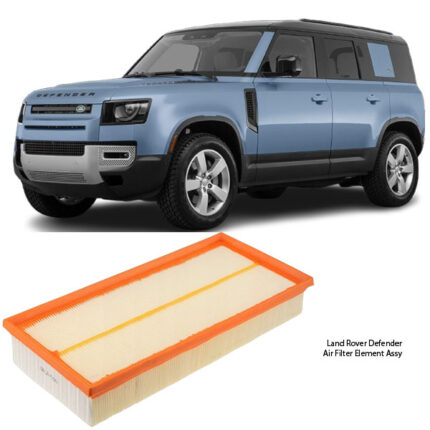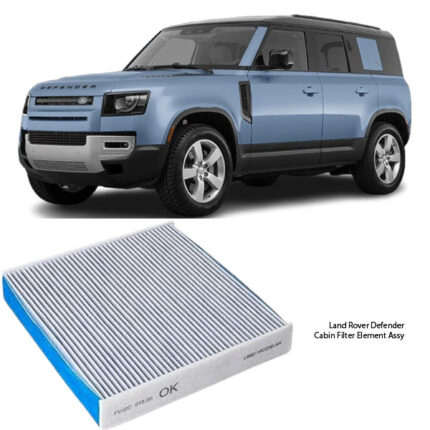-14%
Get Land Rover Defender 2020 Oil Filter Assy LR011279 in Kenya
The Oil Filter Assembly is a vital component in a vehicle’s lubrication system, ensuring that engine oil remains free from contaminants. It prevents dirt, metal particles, and sludge from circulating within the engine, protecting critical components and ensuring smooth performance. This article provides an in-depth explanation of the oil filter assembly, its functions, benefits, types, maintenance, and signs of replacement.
1. What Is an Oil Filter Assembly?
The Oil Filter Assembly consists of a housing, filtration media, anti-drain-back valve, bypass valve, and sealing gaskets. It is designed to remove impurities from engine oil before it reaches vital components such as the crankshaft, camshaft, bearings, and pistons.
As oil circulates through the engine, it picks up contaminants such as carbon deposits, metal shavings, and dirt. Without an efficient filter, these impurities can cause wear, reduce engine efficiency, and lead to major failures.
2. Functions of the Oil Filter Assembly
2.1 Filtering Contaminants from Engine Oil
The primary function of the oil filter is to trap harmful particles before they reach the engine. This prevents sludge buildup and protects components from premature wear.
2.2 Enhancing Engine Lubrication
By removing impurities, the oil filter ensures that clean oil flows smoothly, reducing friction between moving parts and preventing overheating.
2.3 Prolonging Engine Life
Contaminants in the oil can cause abrasive wear on engine components. A high-quality oil filter minimizes this risk, extending the lifespan of critical parts.
2.4 Maintaining Oil Pressure
A well-functioning oil filter maintains optimal oil flow and pressure, ensuring that all engine components receive adequate lubrication.
2.5 Improving Fuel Efficiency
Efficient lubrication reduces friction, allowing the engine to operate smoothly and consume less fuel.
2.6 Reducing Emissions
Clean oil promotes complete combustion, reducing harmful emissions and keeping the engine eco-friendly.
3. Components of an Oil Filter Assembly
3.1 Filter Media
The filter media is the core of the oil filter. It is made from cellulose, synthetic fibers, or microglass and traps contaminants.
3.2 Anti-Drain-Back Valve
Prevents oil from draining out of the filter when the engine is off, ensuring immediate lubrication upon startup.
3.3 Bypass Valve
Opens when the filter is clogged or during cold starts, allowing oil to bypass the filter to prevent engine starvation.
3.4 End Caps and Gaskets
Ensure a secure seal and prevent oil leaks.
3.5 Outer Canister
The durable metal casing protects the filter elements and withstands high oil pressure.
4. Types of Oil Filters
4.1 Full-Flow (Primary) Oil Filters
- Most common in modern vehicles.
- Filters all engine oil before it reaches components.
- Essential for engine protection.
4.2 Bypass Oil Filters
- Provides extra filtration by processing a small portion of the oil.
- Removes finer contaminants that primary filters may miss.
- Common in heavy-duty vehicles.
4.3 Cartridge Oil Filters
- Features a replaceable filter element without a metal canister.
- More environmentally friendly than spin-on filters.
- Typically used in European and modern vehicles.
4.4 Spin-On Oil Filters
- Includes a metal canister and is easy to replace.
- Found in older vehicle models.
- Less eco-friendly compared to cartridge filters.
4.5 Magnetic Oil Filters
- Uses a magnet to trap metal particles from engine oil.
- Often used in performance and industrial applications.
4.6 High-Performance Oil Filters
- Designed for sports cars and racing applications.
- Offers better filtration and higher oil flow rates.
5. Benefits of a High-Quality Oil Filter Assembly
5.1 Increased Engine Longevity
Trapping contaminants prevents engine wear, allowing the vehicle to last longer.
5.2 Enhanced Engine Performance
A clean oil supply ensures smooth operation and optimal power delivery.
5.3 Reduced Maintenance Costs
Using a high-quality oil filter prevents costly engine repairs due to contamination-related damage.
5.4 Better Fuel Economy
Proper lubrication improves efficiency, reducing fuel consumption.
5.5 Lower Emissions
A clean engine burns fuel more efficiently, reducing harmful emissions.
6. Oil Filter Maintenance and Replacement
6.1 How Often Should You Replace an Oil Filter?
- Most manufacturers recommend replacing the oil filter at every oil change (typically every 5,000 – 10,000 miles).
- In extreme driving conditions, more frequent changes may be required.
6.2 Signs That Your Oil Filter Needs Replacement
6.2.1 Low Oil Pressure Warning Light
A clogged oil filter can restrict oil flow, triggering a warning light on the dashboard.
6.2.2 Increased Engine Noise
Insufficient lubrication can cause engine knocking or ticking noises.
6.2.3 Dirty or Dark Oil
If the engine oil becomes excessively dirty between oil changes, the filter may not be functioning effectively.
6.2.4 Poor Performance & Reduced Fuel Economy
A clogged oil filter can increase engine resistance, leading to sluggish performance and higher fuel consumption.
6.2.5 Black Exhaust Smoke
Unfiltered contaminants can lead to incomplete combustion, producing excessive exhaust smoke.
6.3 Steps to Replace an Oil Filter
- Turn off the engine and let it cool.
- Locate the oil filter, usually near the engine block.
- Drain the old oil (if performing an oil change).
- Remove the old filter using an oil filter wrench.
- Lubricate the new filter’s gasket with fresh engine oil.
- Install the new filter and tighten it securely.
- Refill with fresh oil and check for leaks.
7. Choosing the Right Oil Filter
7.1 OEM vs. Aftermarket Oil Filters
- OEM (Original Equipment Manufacturer): Ensures compatibility with factory specifications.
- Aftermarket: May offer improved filtration but should meet industry standards.
7.2 Filtration Efficiency
A higher micron rating (lower number) means better filtration. Look for filters with 10-30 microns for optimal performance.
7.3 Compatibility with Engine Oil
Ensure the filter is designed for your engine’s oil type (synthetic, semi-synthetic, or conventional).
7.4 Driving Conditions
For extreme conditions (towing, racing, off-road), high-performance oil filters provide better durability.
8. Conclusion
The Oil Filter Assembly is a crucial component that ensures clean engine oil, promoting efficiency, durability, and performance. Regular maintenance and timely replacement prevent engine wear, costly repairs, and poor fuel economy.
By investing in a high-quality oil filter, drivers can extend their engine’s lifespan, reduce emissions, and maintain smooth vehicle operation. Always follow the manufacturer’s recommendations and choose the right filter for your vehicle’s needs. 🚗🔧
Follow us on Facebook for more parts.




Reviews
Clear filtersThere are no reviews yet.